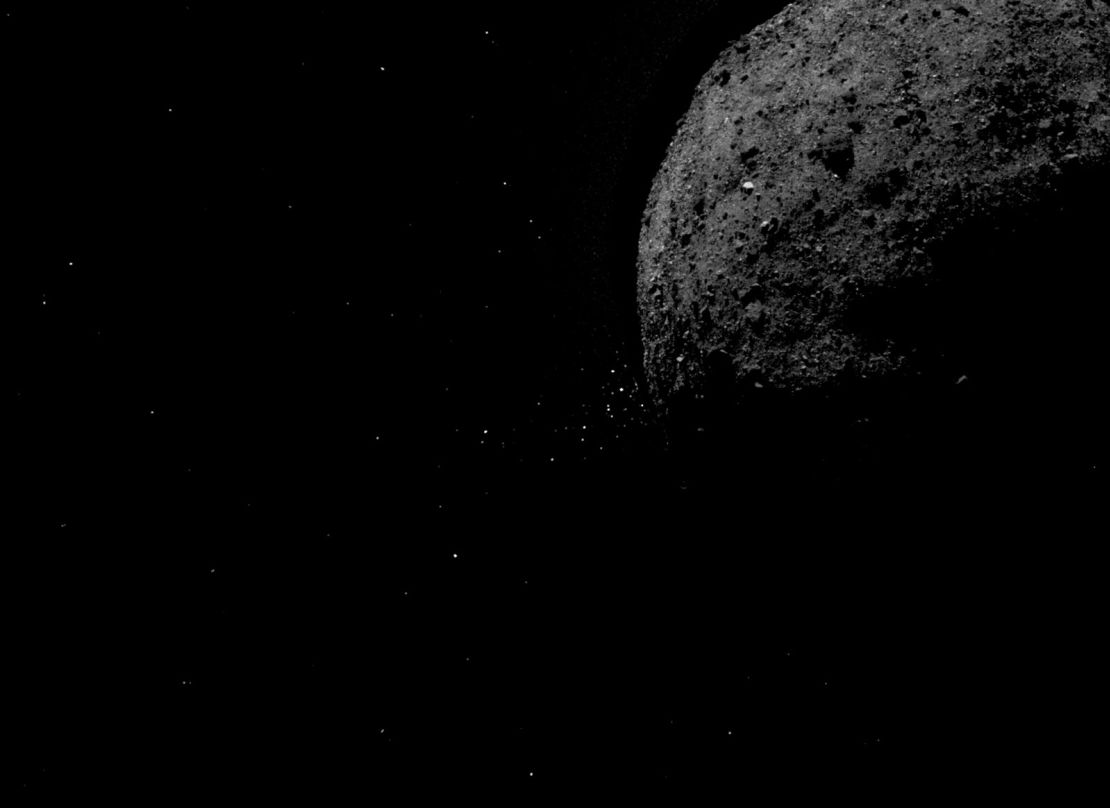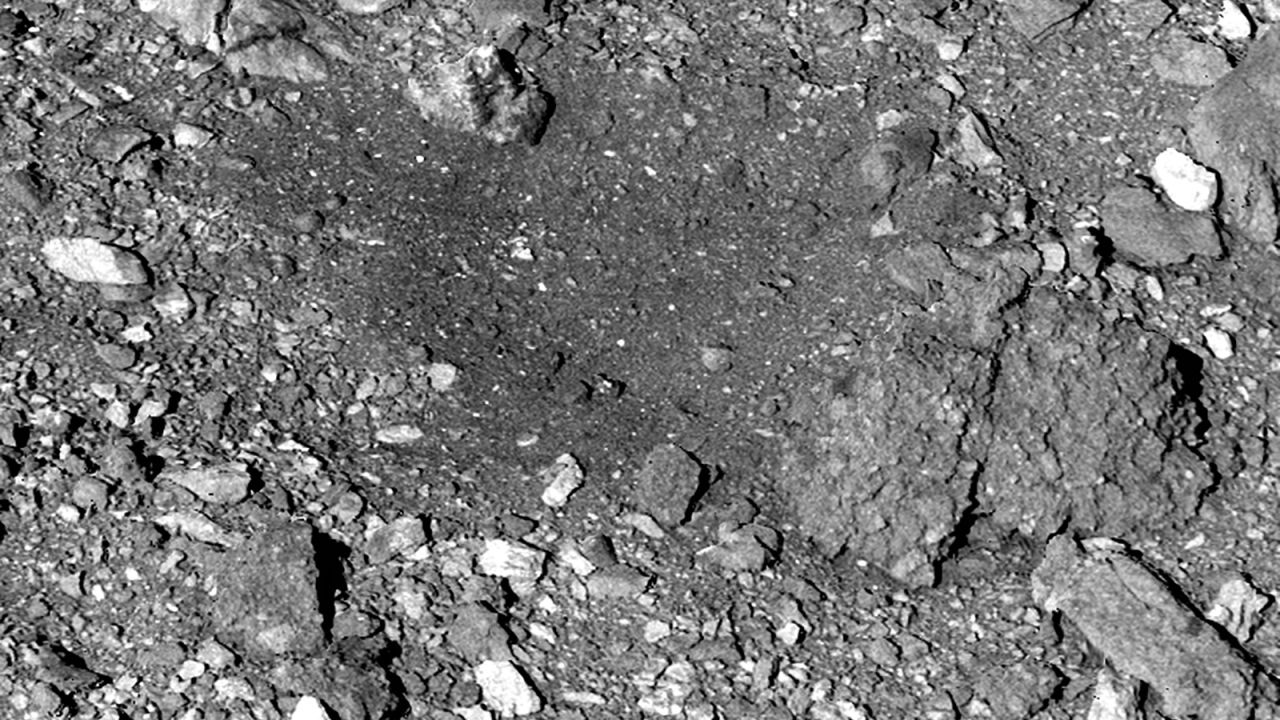Sign up for CNN’s Wonder Theory science newsletter. Explore the universe with news on fascinating discoveries, scientific advancements and more.
A near-Earth asteroid named Bennu has turned out to be full of surprises – the latest of which is the fact that it has a surface similar to a pit of plastic balls, according to NASA scientists.
The new revelation comes after the space agency successfully collected a sample from the asteroid in October 2020.
During the historic collection event, the sampling head of the OSIRIS-REx spacecraft sank 1.6 feet (0.5 meter) into the surface of the asteroid. Apparently, Bennu’s exterior is made of loosely packed particles that aren’t bound together very securely, based on what happened as the spacecraft collected a sample. If the spacecraft hadn’t fired its thruster to back away after its quick collection of dust and rocks, it might have sunk right into the asteroid.
“By the time we fired our thrusters to leave the surface we were still plunging into the asteroid,” said Ron Ballouz, an OSIRIS-REx scientist based at the Johns Hopkins Applied Physics Laboratory in Laurel, Maryland, in a statement. Ballouz is a coauthor of a pair of July studies released in the journals Science and Science Advances about the discovery.
Bennu is a rubble-pile asteroid shaped like a spinning top, composed of rocks bound together by gravity. It’s about one-third of a mile (500 meters) wide.
“If Bennu was completely packed, that would imply nearly solid rock, but we found a lot of void space in the surface,” said study coauthor Kevin Walsh, a member of the OSIRIS-REx science team from Southwest Research Institute in Boulder, Colorado, in a statement.
So what might have happened if the spacecraft’s thrusters didn’t fire right away?
“It may be that OSIRIS-REx would have gone deeper inside the asteroid, which is both fascinating and scary,” said study coauthor Patrick Michel, an OSIRIS-REx scientist and director of research at the Centre National de la Recherche Scientifique at Côte d’Azur Observatory in Nice, France.
Fortunately, the spacecraft and its prized sample are heading back to Earth. The Bennu sample is due to land in September 2023.
Bennu defies expectations
When the spacecraft arrived at Bennu in December 2018, the OSIRIS-Rex team was surprised to find that the asteroid’s surface was covered with boulders. Previous observations had prepared them for a sandy, beachlike terrain.
The scientists also witnessed particles from the asteroid releasing into space.

“Our expectations about the asteroid’s surface were completely wrong,” said study author Dante Lauretta, principal investigator of OSIRIS-REx at the University of Arizona, Tucson, in a statement.
The spacecraft captured images of the site where it collected a sample from Bennu, which further baffled the team. Although OSIRIS-REx very gently tapped the asteroid, it kicked up a massive amount of rocky debris and left a crater 26 feet (8 meters) wide.
“What we saw was a huge wall of debris radiating out from the sample site,” said Lauretta, a regents professor of planetary science and Cosmochemistry at the University of Arizona’s Lunar and Planetary Laboratory. “We were like, ‘Holy cow!’ Every time we tested the sample pickup procedure in the lab, we barely made a divot.”
Before and after photos of the touchdown site show the dramatic difference. The images reveal what looks like a depression in the surface, with several large boulders at its base. The sampling event itself likely caused this sunken landform. The dark surface of the asteroid also has more reflective dust near the collection point, showing where rocks were moved during the event. These changes are evident in the slider below.
When analyzing the spacecraft’s acceleration data, the team determined that it encountered very little resistance, about the same amount someone might feel pushing the plunger on a French press coffee maker.
Understanding more about Bennu’s composition can help scientists studying other asteroids, whether the goal is to plan missions like OSIRIS-REx or protect Earth from potential collisions with space rocks.
An asteroid like Bennu, barely holding itself together, could break apart in Earth’s atmosphere, which might pose other risks even if it’s not a direct hit.
“We need to keep interacting physically with those bodies because this is the only way to really determine their mechanical properties and response to external actions,” Michel said. “Images are crucial but do not give us the answer of whether they are weak or strong.”
OSIRIS-REx – which stands for Origins, Spectral Interpretation, Resource Identification, Security-Regolith Explorer – was the first NASA mission sent to a near-Earth asteroid, and once there it performed the closest orbit of a planetary body by a spacecraft to date. Bennu is the smallest object ever orbited by a spacecraft.
The spacecraft’s souvenir from Bennu is the largest sample collected by a NASA mission since lunar rocks were brought back by Apollo astronauts.
Once OSIRIS-REx approaches Earth in 2023, it will jettison the capsule containing the sample, which will shoot through Earth’s atmosphere and parachute down in the Utah desert.
If OSIRIS-REx is still in good health after it drops off the sample, it will then start on a new expedition to study other asteroids.












